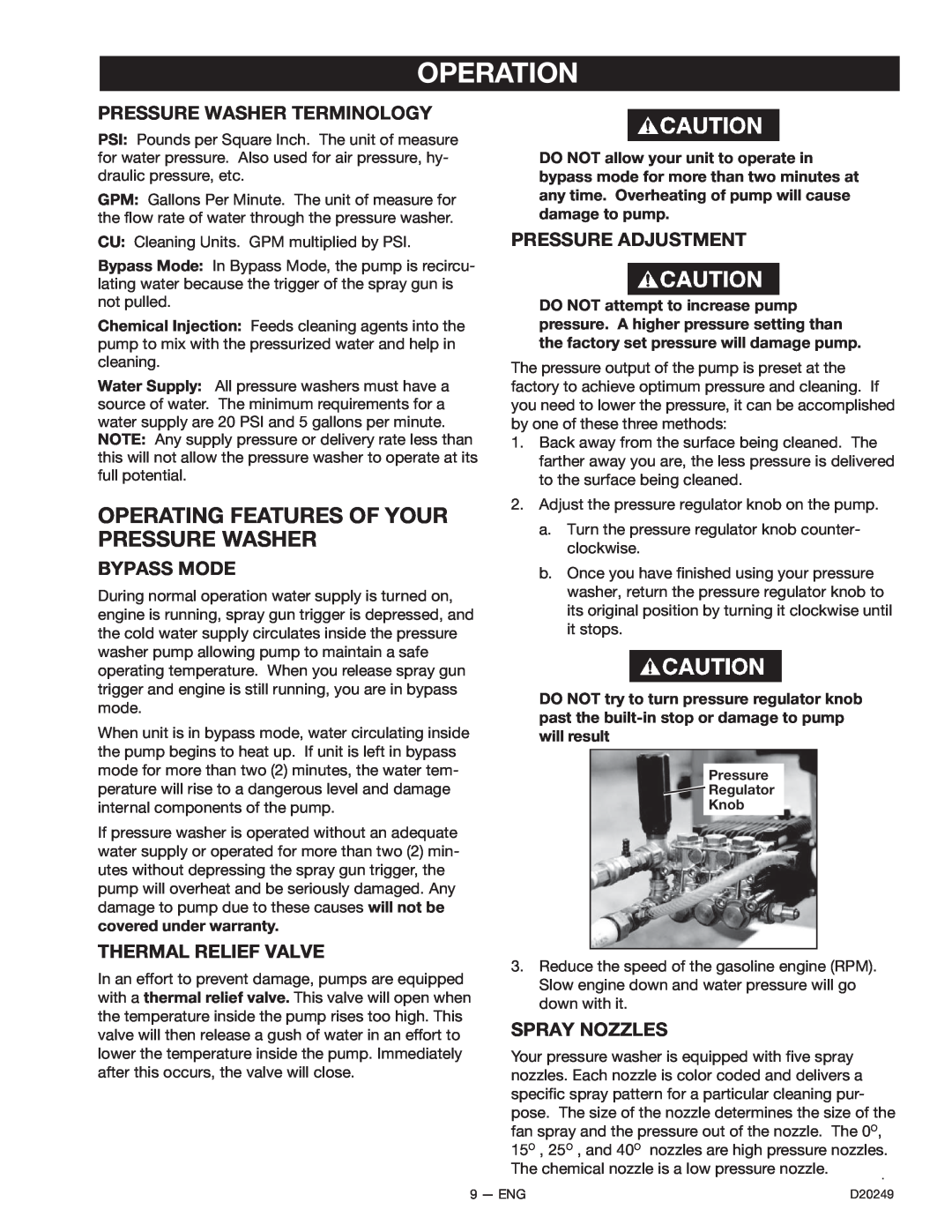
OPERATION
PRESSURE WASHER TERMINOLOGY
PSI: Pounds per Square Inch. The unit of measure for water pressure. Also used for air pressure, hy- draulic pressure, etc.
GPM: Gallons Per Minute. The unit of measure for the flow rate of water through the pressure washer.
CU: Cleaning Units. GPM multiplied by PSI.
Bypass Mode: In Bypass Mode, the pump is recircu- lating water because the trigger of the spray gun is not pulled.
Chemical Injection: Feeds cleaning agents into the pump to mix with the pressurized water and help in cleaning.
Water Supply: All pressure washers must have a source of water. The minimum requirements for a water supply are 20 PSI and 5 gallons per minute.
NOTE: Any supply pressure or delivery rate less than this will not allow the pressure washer to operate at its full potential.
OPERATING FEATURES OF YOUR PRESSURE WASHER
BYPASS MODE
During normal operation water supply is turned on, engine is running, spray gun trigger is depressed, and the cold water supply circulates inside the pressure washer pump allowing pump to maintain a safe operating temperature. When you release spray gun trigger and engine is still running, you are in bypass mode.
When unit is in bypass mode, water circulating inside the pump begins to heat up. If unit is left in bypass mode for more than two (2) minutes, the water tem- perature will rise to a dangerous level and damage internal components of the pump.
If pressure washer is operated without an adequate water supply or operated for more than two (2) min- utes without depressing the spray gun trigger, the pump will overheat and be seriously damaged. Any damage to pump due to these causes will not be covered under warranty.
THERMAL RELIEF VALVE
In an effort to prevent damage, pumps are equipped with a thermal relief valve. This valve will open when the temperature inside the pump rises too high. This valve will then release a gush of water in an effort to lower the temperature inside the pump. Immediately after this occurs, the valve will close.
DO NOT allow your unit to operate in bypass mode for more than two minutes at any time. Overheating of pump will cause damage to pump.
PRESSURE ADJUSTMENT
DO NOT attempt to increase pump pressure. A higher pressure setting than the factory set pressure will damage pump.
The pressure output of the pump is preset at the factory to achieve optimum pressure and cleaning. If you need to lower the pressure, it can be accomplished by one of these three methods:
1.Back away from the surface being cleaned. The farther away you are, the less pressure is delivered to the surface being cleaned.
2.Adjust the pressure regulator knob on the pump.
a.Turn the pressure regulator knob counter- clockwise.
b.Once you have finished using your pressure washer, return the pressure regulator knob to its original position by turning it clockwise until it stops.
DO NOT try to turn pressure regulator knob past the
Pressure
![]() Regulator
Regulator
Knob
3.Reduce the speed of the gasoline engine (RPM). Slow engine down and water pressure will go down with it.
SPRAY NOZZLES
Your pressure washer is equipped with five spray nozzles. Each nozzle is color coded and delivers a specific spray pattern for a particular cleaning pur- pose. The size of the nozzle determines the size of the fan spray and the pressure out of the nozzle. The 0O, 15O , 25O , and 40O nozzles are high pressure nozzles. The chemical nozzle is a low pressure nozzle.
9 — ENG | D20249 |
